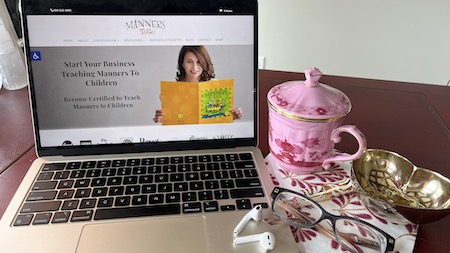“Poise” refers to a sense of graceful composure and self-assuredness in various situations. It involves maintaining an elegant, balanced and confident demeanor regardless of the circumstances.
What is Poise?

Poise is often associated with a calm and collected presence that exudes confidence and control.
Poise is a very popular topic when teaching manners and social skills to children.
Teaching poise within a manners program involves a combination of developing self-awareness, practicing mindfulness, improving physical posture and body language, and building emotional resilience. Here are some steps to help teach and cultivate poise:
How to Teach Poise in a Manners and Etiquette Class
- Self-awareness: Help individuals become more aware of their emotions, thoughts, and physical sensations. This awareness is crucial in understanding how they react to different situations and learning to manage their responses.
- Mindfulness: Encourage mindfulness practices such as meditation, deep breathing exercises, and progressive muscle relaxation. These techniques help individuals stay present, manage stress, and respond to situations in a composed manner.
- Confidence-building: Work on building self-confidence by acknowledging and celebrating personal achievements and strengths. Set achievable goals and help individuals recognize their progress.
- Positive self-talk: Teach the importance of positive self-talk and help individuals replace self-doubt with affirmations and constructive thoughts. This can significantly impact their overall self-image and poise.
- Physical posture: Proper posture contributes to a sense of poise. Teach individuals how to stand and sit up straight, aligning their body to project confidence and grace. Good posture also has positive effects on mental and emotional well-being.
- Body language: Educate individuals about the significance of body language in conveying poise. Encourage open and relaxed gestures, steady eye contact, and a friendly smile. Practicing these behaviors can enhance their overall presence.
- Breathing techniques: Teach deep breathing techniques that help in calming the nervous system and reducing stress. Controlled breathing can be used in challenging situations to maintain composure.
- Stress management: Guide individuals on effective stress management strategies such as time management, prioritization, and setting boundaries. When they feel in control of their responsibilities, it becomes easier to maintain poise.
- Practice composure: Role-playing and simulated scenarios can help individuals practice maintaining poise in challenging situations. This can build their ability to respond calmly and thoughtfully even when faced with unexpected challenges.
- Emotional resilience: Teach individuals to manage their emotions and respond rationally rather than react impulsively. Encourage problem-solving and a focus on solutions rather than dwelling on problems.
- Social skills: Help individuals improve their communication and social skills. The ability to engage in meaningful conversations and connect with others in various situations enhances their overall poise.
- Modeling: Be a role model by demonstrating poise in your own behavior. Share personal stories of how you’ve overcome challenges and maintained composure.
Remember that developing poise is an ongoing process that requires patience and practice.
Etiquette experts who have been trained and certified offer a great deal of value to their community.
Let us know how we can help you start business that serves parents and children in your area.
It’s about cultivating a sense of inner calm and confidence that shines through in various aspects of life.
Have you read our article about Freedom and Passion When Owning Your Business? Click here.
Here is a FREE Guide to Help YOU Start a Business Teaching Manners to Children
CLICK THE IMAGE TO GET THE DOWNLOAD RIGHT NOW
Here Are Your Next Steps

Get to Know Manners To Go™
Most likely, you will want to get to know us. Feel free to call or email us. Click on the links below. We are happy to discuss the details with you.

Decide on the best training option for you
We offer two trainings to become certified to teach manners to children:

Option #1:
“Live” Video Training
If you are looking to start immediately and save money on travel and time, then this is your best option.You choose the dates of our trainings. Most choose to have their sessions once a week, others twice. This is a “live” and private training. It is NOT self-guided.

Option #2:
Two-Day In-Person
PRIVATE Training. That’s right, we meet in person, the two of us and our focus is completely on your business. Click the image above or follow the button below to learn more and to see a list of cities available for your training.

Receive the curriculum and book your training dates
Upon payment, you receive the curriculum. Next, we will send an email asking you to schedule your first training date.



 Lisa Richey provides etiquette programs to businesses, schools, and individuals.
Lisa Richey provides etiquette programs to businesses, schools, and individuals.



